Advertisement
How to exercise as you age

Forty may be the new 30. But if you’re approaching (or past) the mid-century mark, you probably don’t want to work out like a 20-year-old — no matter how spry you feel.
Advertisement
Cleveland Clinic is a non-profit academic medical center. Advertising on our site helps support our mission. We do not endorse non-Cleveland Clinic products or services. Policy
“Exercise is really important as you get older,” says Tom Iannetta ATC, CSCS, a senior athletic trainer and certified strength and conditioning specialist. “But you might have to adjust your routine to avoid injuries as you age.”
Here’s how to exercise safely, in middle age and beyond.
You don’t have to abandon your favorite exercise just because you’re getting older. People are staying active well into their later years. “There’s no reason you can’t stay active past 50. You can keep playing tennis or softball, golfing or doing any of the things you’ve always enjoyed,” Iannetta says.
But that doesn’t mean you can push yourself quite like you did at 25.
“As you get older, muscles and tendons get tighter,” he says. “Injuries like tendon tears become a lot more common in middle age. It’s important to know your limits and listen to your body.”
Luckily, you can take steps to reduce the risk of injury.
Advertisement
Before starting a new exercise program, talk to your doctor, Iannetta says. They can give you advice about what is and isn’t safe. That’s especially true if you’re taking medications or have any chronic conditions such as lung disease or heart problems.
As you get started, it’s worth seeking help from the experts, he adds. “Look for a certified strength and conditioning specialist or a certified personal trainer,” he says. “They can help you find enjoyable ways to exercise safely.”
Once you get the all-clear, where do you begin? Iannetta offers these ideas to get you started.
The most important pointer for exercising in your 40s, 50s, 60s, 70s and beyond? You do you.
Don’t worry about what your buddy is doing or stress about keeping up with the younger crowd.
“More isn’t always better,” Iannetta says. “There’s no shame in adapting your routine as you get older. It’s the movement, not the method that matters.”
Advertisement
Learn more about our editorial process.
Advertisement

Stretch before and after your workouts for maximum benefits, but your pre-workout stretches should be different from your post-workout stretches

This low-impact, full-body workout builds strength and stamina while reducing stress

Exercising can actually improve arthritis symptoms — and low-impact exercises are best

Bulgarian split squats, hack squats and goblet squats are just a few of the moves you can try

While walking, be mindful of your body, your mind, your place in the world and all five of your senses as you pave a path forward, one step at a time

Squat smart with proper technique, including a neutral spine, wide knees and an engaged core

This important step gives your body time to return to its resting state while reducing muscle cramps, dizziness and injury

The short answer? The best exercise is the one you’ll actually do

Focus on your body’s metabolic set point by eating healthy foods, making exercise a part of your routine and reducing stress

PFAS chemicals may make life easier — but they aren’t always so easy on the human body

While there’s little risk in trying this hair care treatment, there isn’t much science to back up the claims